Common angiotensin receptor blockers may directly modulate the immune system via VDR, PPAR and CCR2b
- PMID: 16403216
- PMCID: PMC1360063
- DOI: 10.1186/1742-4682-3-1
Common angiotensin receptor blockers may directly modulate the immune system via VDR, PPAR and CCR2b
Abstract
Background: There have been indications that common Angiotensin Receptor Blockers (ARBs) may be exerting anti-inflammatory actions by directly modulating the immune system. We decided to use molecular modelling to rapidly assess which of the potential targets might justify the expense of detailed laboratory validation. We first studied the VDR nuclear receptor, which is activated by the secosteroid hormone 1,25-dihydroxyvitamin-D. This receptor mediates the expression of regulators as ubiquitous as GnRH (Gonadatrophin hormone releasing hormone) and the Parathyroid Hormone (PTH). Additionally we examined Peroxisome Proliferator-Activated Receptor Gamma (PPARgamma), which affects the function of phagocytic cells, and the C-CChemokine Receptor, type 2b, (CCR2b), which recruits monocytes to the site of inflammatory immune challenge.
Results: Telmisartan was predicted to strongly antagonize (Ki asymptotically equal to 0.04 nmol) the VDR. The ARBs Olmesartan, Irbesartan and Valsartan (Ki asymptotically equal to10 nmol) are likely to be useful VDR antagonists at typical in-vivo concentrations. Candesartan (Ki asymptotically equal to 30 nmol) and Losartan (Ki asymptotically equal to 70 nmol) may also usefully inhibit the VDR. Telmisartan is a strong modulator of PPARgamma (Ki asymptotically equal to 0.3 nmol), while Losartan (Ki asymptotically equal to 3 nmol), Irbesartan (Ki asymptotically equal to 6 nmol), Olmesartan and Valsartan (Ki asymptotically equal to 12 nmol) also seem likely to have significant PPAR modulatory activity. Olmesartan and Irbesartan (Ki asymptotically equal to 9 nmol) additionally act as antagonists of a theoretical model of CCR2b. Initial validation of this CCR2b model was performed, and a proposed model for the Angiotensin II Type1 receptor (AT2R1) has been presented.
Conclusion: Molecular modeling has proven valuable to generate testable hypotheses concerning receptor/ligand binding and is an important tool in drug design. ARBs were designed to act as antagonists for AT2R1, and it was not surprising to discover their affinity for the structurally similar CCR2b. However, this study also found evidence that ARBs modulate the activation of two key nuclear receptors-VDR and PPARgamma. If our simulations are confirmed by experiment, it is possible that ARBs may become useful as potent anti-inflammatory agents, in addition to their current indication as cardiovascular drugs.
Figures




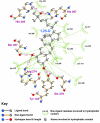


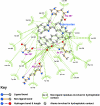
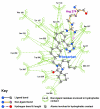
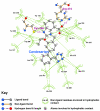
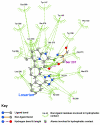
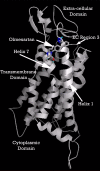


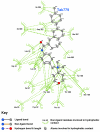



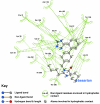

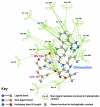

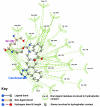

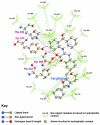
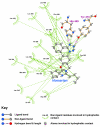
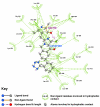
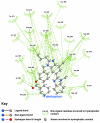
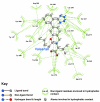
Similar articles
-
Molecular activation of PPARgamma by angiotensin II type 1-receptor antagonists.Vascul Pharmacol. 2006 Sep;45(3):154-62. doi: 10.1016/j.vph.2006.05.002. Epub 2006 May 16. Vascul Pharmacol. 2006. PMID: 16765099
-
Inhibition of cardiovascular cell proliferation by angiotensin receptor blockers: are all molecules the same?J Hypertens. 2008 May;26(5):973-80. doi: 10.1097/HJH.0b013e3282f56ba5. J Hypertens. 2008. PMID: 18398340
-
Telmisartan is the most effective ARB to increase adiponectin via PPARα in adipocytes.J Mol Endocrinol. 2022 May 10;69(1):259-268. doi: 10.1530/JME-21-0239. J Mol Endocrinol. 2022. PMID: 35354667
-
Class- and molecule-specific differential effects of angiotensin II type 1 receptor blockers.Curr Pharm Des. 2013;19(17):3002-8. doi: 10.2174/1381612811319170005. Curr Pharm Des. 2013. PMID: 23176212 Review.
-
The vitamin D hormone and its nuclear receptor: molecular actions and disease states.J Endocrinol. 1997 Sep;154 Suppl:S57-73. J Endocrinol. 1997. PMID: 9379138 Review.
Cited by
-
AT1R blockade in adverse milieus: role of SMRT and corepressor complexes.Am J Physiol Renal Physiol. 2015 Aug 1;309(3):F189-203. doi: 10.1152/ajprenal.00476.2014. Epub 2015 Jun 17. Am J Physiol Renal Physiol. 2015. PMID: 26084932 Free PMC article.
-
A small difference in the molecular structure of angiotensin II receptor blockers induces AT₁ receptor-dependent and -independent beneficial effects.Hypertens Res. 2010 Oct;33(10):1044-52. doi: 10.1038/hr.2010.135. Epub 2010 Jul 29. Hypertens Res. 2010. PMID: 20668453 Free PMC article.
-
Is the fixed-dose combination of telmisartan and hydrochlorothiazide a good approach to treat hypertension?Vasc Health Risk Manag. 2007;3(3):265-78. Vasc Health Risk Manag. 2007. PMID: 17703634 Free PMC article. Review.
-
Irbesartan, an angiotensin II type 1 receptor blocker, inhibits colitis-associated tumourigenesis by blocking the MCP-1/CCR2 pathway.Sci Rep. 2021 Oct 7;11(1):19943. doi: 10.1038/s41598-021-99412-8. Sci Rep. 2021. PMID: 34620946 Free PMC article.
-
Recent advances in the treatment of pathogenic infections using antibiotics and nano-drug delivery vehicles.Drug Des Devel Ther. 2019 Jan 18;13:327-343. doi: 10.2147/DDDT.S190577. eCollection 2019. Drug Des Devel Ther. 2019. PMID: 30705582 Free PMC article. Review.
References
-
- United States Food and Drug Administration Approval Package for NDA21-286 http://www.fda.gov/cder/foi/nda/2002/21-286_Benicar_pharmr_P1.pdf Pharmacology Review, figures 1.1.1.1,1.1.1.3 and1.1.1.4.
MeSH terms
Substances
LinkOut - more resources
Full Text Sources
Other Literature Sources

